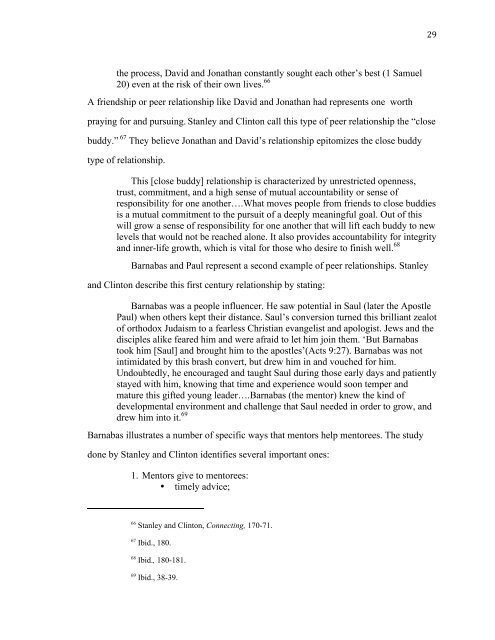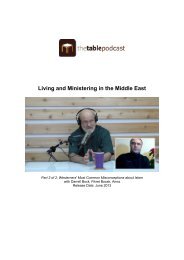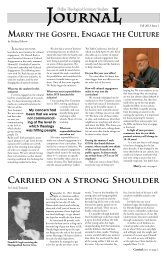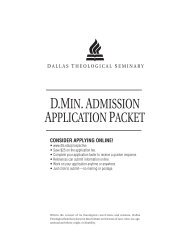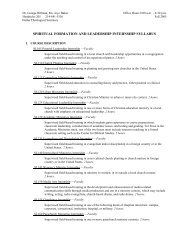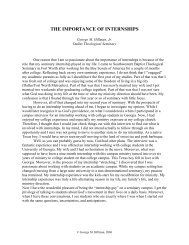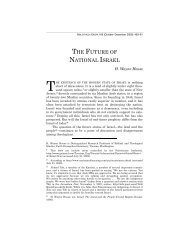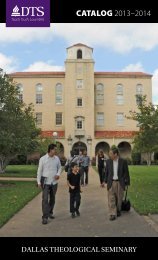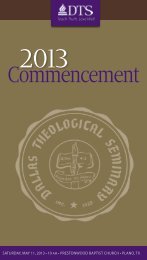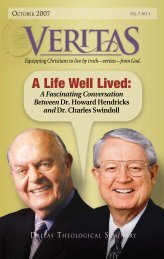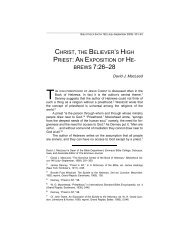Complete Dissertaton - Final for Print with new editing - Dallas ...
Complete Dissertaton - Final for Print with new editing - Dallas ...
Complete Dissertaton - Final for Print with new editing - Dallas ...
Create successful ePaper yourself
Turn your PDF publications into a flip-book with our unique Google optimized e-Paper software.
29 <br />
the process, David and Jonathan constantly sought each other’s best (1 Samuel<br />
20) even at the risk of their own lives. 66<br />
A friendship or peer relationship like David and Jonathan had represents one worth<br />
praying <strong>for</strong> and pursuing. Stanley and Clinton call this type of peer relationship the “close<br />
buddy.” 67 They believe Jonathan and David’s relationship epitomizes the close buddy<br />
type of relationship.<br />
This [close buddy] relationship is characterized by unrestricted openness,<br />
trust, commitment, and a high sense of mutual accountability or sense of<br />
responsibility <strong>for</strong> one another….What moves people from friends to close buddies<br />
is a mutual commitment to the pursuit of a deeply meaningful goal. Out of this<br />
will grow a sense of responsibility <strong>for</strong> one another that will lift each buddy to <strong>new</strong><br />
levels that would not be reached alone. It also provides accountability <strong>for</strong> integrity<br />
and inner-life growth, which is vital <strong>for</strong> those who desire to finish well. 68<br />
Barnabas and Paul represent a second example of peer relationships. Stanley<br />
and Clinton describe this first century relationship by stating:<br />
Barnabas was a people influencer. He saw potential in Saul (later the Apostle<br />
Paul) when others kept their distance. Saul’s conversion turned this brilliant zealot<br />
of orthodox Judaism to a fearless Christian evangelist and apologist. Jews and the<br />
disciples alike feared him and were afraid to let him join them. ‘But Barnabas<br />
took him [Saul] and brought him to the apostles’(Acts 9:27). Barnabas was not<br />
intimidated by this brash convert, but drew him in and vouched <strong>for</strong> him.<br />
Undoubtedly, he encouraged and taught Saul during those early days and patiently<br />
stayed <strong>with</strong> him, knowing that time and experience would soon temper and<br />
mature this gifted young leader….Barnabas (the mentor) k<strong>new</strong> the kind of<br />
developmental environment and challenge that Saul needed in order to grow, and<br />
drew him into it. 69<br />
Barnabas illustrates a number of specific ways that mentors help mentorees. The study<br />
done by Stanley and Clinton identifies several important ones:<br />
1. Mentors give to mentorees:<br />
• timely advice;<br />
66 Stanley and Clinton, Connecting, 170-71.<br />
67 Ibid., 180.<br />
68 Ibid., 180-181.<br />
69 Ibid., 38-39.


